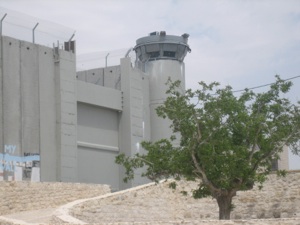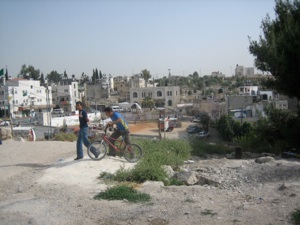Wall
(Separation Barrier)

Wall
(Separation Barrier)

Since 2002 Israel has been building a wall or separation/apartheid barrier between Israel and the West Bank. Israel says that the barrier is for security purposes. Whether or not this is the intent, it is indisputable that the wall grabs further Palestinian land for Israel proper. It is intended to build only 25% on the green line (the 1948 border), 75% taking a strangely circuitous route inside the West Bank, making it a total of 724 km, long (twice as long as the green line). The route is planned to annex as much land and incorporate as little Palestinian population as possible. The route taken by the wall will have the effect of annexing 10% of the West Bank, serving to incorporate into Israel proper Israeli settlements built in the West Bank and seizing further land for expansion.
In July 2004 the International Court of Justice at the Hague gave the advisory opinion that the wall is illegal, saying that Israel must immediately terminate construction, dismantle the sections built, that it must return confiscated properties and that Palestinians affected by the construction must be compensated. Further, that all states are under an obligation not to recognise the illegal situation resulting from the wall’s construction, nor render aid nor assist the maintaining of the situation created by the construction. Israel has continued to construct it.
Physically the wall consists variously of huge concrete slabs or electric wired fences and razor wire. Apparently vicious dogs are also used to patrol. The wall is up to 8m high; twice as high as the former Berlin wall. It is punctuated by watch-towers manned by armed soldiers, with cameras, and the occasional checkpoint for those with permits to cross through. The barrier itself plus supply roads is in area 60-100 metres wide, thus taking up yet more land. Sometimes the path of the wall ploughs straight through communities, as in Abu Dis in Greater Jerusalem.
The path of the wall has had the effect of creating six ghettos in the occupied territories, containing 98 enclaves, with 312,810 Palestinians surrounded by barbed wire, walls and control towers; at least 14,364 persons have been displaced in the 145 localities through which the wall passes with some 90,000 Palestinians directly threatened by displacement as the construction is completed. (Badil, 8 July 2009). The wall serves to cut Jerusalem off from its natural commuter towns, thus fracturing Palestinian community. It further separates farmers from what was previously their land.
The wall is known in Israel as the ‘separation’ (Hebrew hafrada) wall; elsewhere as the ‘apartheid’ wall (which is equivalent, apartheid meaning ‘to set apart’). In Israel it is cast as the solution to the Palestinian ‘problem’, separating-off the Palestinians and confining them. It is however highly spurious to say that the wall solves what the Israelis see as a security problem. There was no wall found necessary during the first intifada; the wall was planned at a time when Palestinian suicide attacks on Israeli society were few in number; and the fact that 100,000 Palestinians have been picked up illegally present in Israel proper would indicate that (at least while it is incomplete) people will get through if they are determined enough. Rather is the wall an instrument of control of the Palestinian people. To use Jeff Halper’s language, it ‘warehouses’ them as unwanted. Behind the wall, the Palestinians are out of sight and out of mind. The control is of course very great; in effect four soldiers, one at each of the checkpoints into Bethlehem, can close off and contain that city at will in a matter of minutes.
Some Palestinian villages are now almost surrounded by the wall. (See box on Ni’lin.). The Israeli ‘solution’ (again horrendously expensive, as is the wall itself) is to build tunnels and sunken roads for the Palestinians, so that they can reach places of work, or children their schools, in the nearest Palestinian town without their having to cross ‘Israeli’ land (that is to say land Israel has appropriated). The problem is that tunnels are only open for a matter of maybe two hours a day, sometimes for 15 minutes, sometimes even at whim when the Israeli soldiers so choose. This creates havoc in people’s lives. But this is the whole point. It is hoped that the impossibility of the situation will drive people out of the villages and off the land into the Palestinian towns; whereupon the Israelis will be able to take over the land. Psychologically it is terrible.
It is as though Israel will forge two entirely separate societies. (See Solutions?, The Bantustan Non-Solution.) Not allowed into the West Bank other than on military duty (which itself cuts off a young Israeli Jew from the people he or she is controlling), many an Israeli has apparently never met Palestinians from the occupied territories, never seen the matrix of control in the West Bank. After I had spent a week there I was seriously told that I knew more of the West Bank than did most Israelis. What must impress one is that, in such a small area geographically, two communities live cheek by jowl. Only as a foreigner can one (if one is so minded) move between them. The two communities are, of course, worlds apart. In Israel proper, which is often beautiful, with expensive houses and wonderfully designed public buildings, one can be simply unaware of this underworld, or other-world, on one’s doorstep. Israel is spacious. By contrast - now that Palestinians have been deprived of East Jerusalem as their main town - Ramallah simply teems with people. For some the wall spells catastrophe, cutting them off from family, work, hospitals or places of worship. The wall is reckoned to harm the Palestinian economy to the tune of $200 million a year – and Israel does not, of course, pay compensation.
Protest Against the Wall
Bethlehem
During the process of building the wall at Bethlehem, protesters, both children and adults, were killed. The course of the wall was to take was to divide the children of the refugee camp from land on which formerly they had played. (See the photograph above.) One boy playing on a roof and having fun was shot at by a soldier in a watch tower for no apparent reason (perhaps because he looked happy?). Locally I heard it said that 280 bullets were found in the bodies of four people who were killed.
Ni’lin
11 miles West of Ramallah and on the border with Israel proper Ni’lin is a Palestinian town of nearly five thousand inhabitants. The wall is being built on a line such that much of the land the people of Ni’lin previously farmed will be taken away. An agricultural community dependent on their land, each Friday they hold a non-violent protest against the wall. The Israeli security forces are frequently provocative and a number have lost their lives. The protests have become well known and some from abroad have joined in. In March 2009 a Californian who had joined the demonstration was critically injured when hit by a gas canister fired by the IDF.
Since Jan. 2010 there has been an escalation of repression against human rights defenders and more arrests. On 13 August 2010 it was reported that ‘dozens of Palestinian and International protestors were wounded. Israeli troops fired a number of tear gas canisters and stun grenades at the protesters who marched after the Friday prayer to protest the construction of the wall on their lands. Sources from the village said that after the march was over, Israeli soldiers chased the protesters back to the village and stopped some youth and assaulted them.’ (IMEMC News)

Children with only the streets of the
Refugee camp left to play in.

Ni’lin
See picture of the wall being built at Ni’lin under ‘Water and the Land’.

The wall at Bethlehem, with the land visible beyond where the children from the refugee camp used formerly to play.
See Further on this Site:
See Futher:
Christian Peacemaker Teams ‘Palestine: Open Letter to Obama - call on Israel to stop suppressing Palestinian dissent’.
Podcasts:
-‘In Praise of the People of Nilin’. (Nilin marking the 20-year anniversary of the fall of the Berlin wall by taking down the wall on their land!) Also available on facebook here.
-War on Want ‘Palestinian activist speaks about the illegal separation wall’.
-Aljazeera ‘Palestinians and Israelis against the wall’
